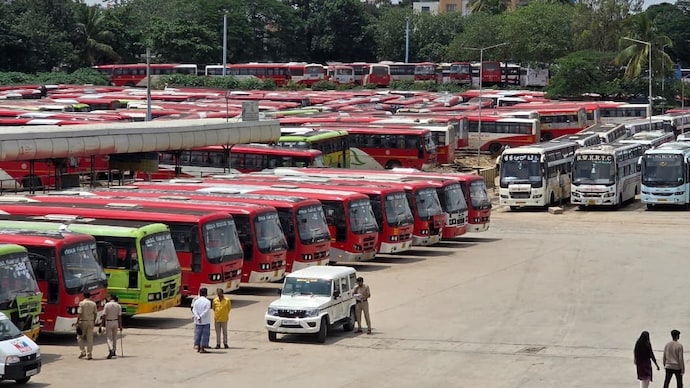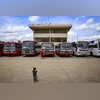On August 5, 2025, transport workers from Karnataka’s four major state-run corporations—KSRTC, BMTC, NWKRTC, and KKRTC—launched an indefinite strike, crippling the public transport system. Despite a Karnataka High Court stay order, employees walked off their duties, protesting unpaid salary arrears and stalled wage revisions. Cities like Bengaluru, Mysuru, Mangaluru, and Hubballi faced massive disruptions, with thousands of commuters stranded at bus stops. The government scrambled to implement emergency measures to contain the situation, while the defiant unions stood firm on their demands, bringing public services to a near standstill across the state.
The strike has inflicted a significant blow to Karnataka’s economy, with daily revenue losses estimated to exceed ₹50 crore. The absence of state-run transport services has crippled logistics, delayed goods movement, and affected small-scale industries reliant on timely deliveries. Markets in Bengaluru, Mysuru, and Tier-2 cities witnessed sharp declines in foot traffic, impacting retail and service sectors. Tourism, a key contributor to state GDP, also took a hit as tourists cancelled plans amidst transport uncertainty. The cascading economic disruption underscores the critical role of public transport as a backbone for commerce and daily livelihood in Karnataka.
Political Fallout for the State Government
The strike has escalated into a political crisis, with opposition parties accusing the Congress-led Karnataka government of administrative failure. The inability to preemptively resolve worker grievances has given the opposition a potent narrative against Chief Minister Siddaramaiah’s leadership. Critics point to repeated mishandling of essential services and delayed wage settlements as systemic governance lapses. The government’s invocation of ESMA has been portrayed as high-handed, further polarizing public sentiment. This deadlock, if prolonged, could influence voter perception ahead of local body elections, making it not just a labour dispute but a politically charged standoff.

Legal Hurdles & ESMA Enforcement Challenges
While the state has invoked ESMA to declare the strike illegal, enforcing compliance remains a complex challenge. Legal experts argue that coercive action against striking workers could backfire, deepening worker dissatisfaction and escalating the conflict. Courts are treading cautiously, balancing the right to protest with the disruption of essential services. The effectiveness of ESMA is also questioned, as mass workforce participation in the strike dilutes the state’s enforcement capacity. The legal tussle over ESMA’s applicability is expected to set important precedents on labour rights versus public service continuity in essential sectors.
Long-Term Labour Relations Crisis
The strike has exposed a deep-seated crisis in labour relations within Karnataka’s public transport sector. Years of wage stagnation, delayed arrear payments, and opaque grievance redressal mechanisms have created simmering resentment among employees. This strike is not an isolated event but a manifestation of chronic neglect and mismanagement. Unless systemic reforms are introduced—including structured wage revision cycles, grievance mediation bodies, and transparent financial accountability—such disruptions are likely to recur. A long-term resolution requires overhauling the state’s approach to public sector human resource management, with a focus on sustainable workforce welfare policies.
Public Transport Resilience Under Scrutiny
The strike has starkly highlighted the fragility of Karnataka’s public transport infrastructure. With lakhs of daily commuters reliant on KSRTC, BMTC, and allied services, the lack of alternative contingency mechanisms led to immediate urban paralysis. The absence of an integrated emergency mobility plan, inadequate last-mile connectivity, and over-reliance on state-run buses have all come under scrutiny. Experts now emphasize the need for diversified public transport models, incorporating private partnerships, strengthening metro rail networks, and developing smart urban mobility grids to ensure resilience against future service disruptions.
Commuter Adaptation & Emerging Trends
In the wake of the strike, commuters have been forced to explore alternative mobility options. Carpooling groups, community shuttle services, and app-based cab pooling have gained prominence, especially in Bengaluru. Bicycles and e-scooters saw increased adoption for short-distance commutes. However, these adaptations remain insufficient for the vast majority, particularly in rural belts. The crisis has exposed both the adaptability and limitations of urban commuting alternatives in the absence of large-scale public transport. It has also triggered discussions on promoting sustainable, decentralized transport ecosystems that are less vulnerable to centralized service breakdowns.
Private Sector Involvement & Contractual Workforce
The government’s attempt to rope in private bus operators and contractual drivers as stopgap measures faced logistical hurdles and limited success. While a few routes were revived, the scale of Karnataka’s public transport needs overwhelmed these temporary arrangements. The crisis has reignited debates on privatization and Public-Private Partnerships (PPP) in state transport services. Proponents argue that diversified service models could offer agility, while critics caution against the erosion of job security and service quality in a privatized ecosystem. The situation has revived urgent discussions on striking a balance between public sector stability and private sector efficiency.
Student Protests & Social Unrest
The transport strike’s impact on education sectors has sparked student-led protests, especially in university towns like Mysuru and Dharwad. With examinations approaching and transport halted, students voiced demands for immediate restoration of services or postponement of academic schedules. Social unrest is gradually simmering, with calls for wider solidarity protests emerging among student unions and labour rights organizations. The fear of a broader civil agitation looms if the deadlock persists. The strike’s ripple effects have thus transcended labour circles, spilling into the social fabric, amplifying the urgency for a swift, negotiated resolution.
Impact on Women and Vulnerable Populations
Women, elderly citizens, and daily wage earners are among the hardest hit by the transport shutdown. Many women, particularly in lower-income brackets, rely on affordable public buses for commuting to work, markets, and schools. With services paralyzed, their mobility has been severely curtailed, impacting income and daily household functions. Vulnerable groups have limited access to costly alternatives like cabs or autos. The strike has laid bare the socio-economic inequities embedded in Karnataka’s transport infrastructure, where service disruptions disproportionately affect those with the least financial cushioning, deepening existing vulnerabilities.
Future Outlook: Policy Reforms & Strategic Lessons
The Karnataka Transport Strike is poised to be a case study in public service vulnerability and governance responsiveness. Policymakers are under pressure to initiate structural reforms in wage settlement processes, develop rapid mobility contingency frameworks, and fortify legal mechanisms that balance worker rights with service continuity. The crisis has also rekindled the importance of investing in multi-modal transport systems that can function autonomously during sector-specific disruptions. As negotiations continue, Karnataka’s transport sector faces a pivotal juncture—either emerge resilient with forward-looking reforms or risk chronic service instability with recurring cycles of industrial action.
Worker Demands & Government Offer
The striking employees are demanding settlement of 38 months of pending salary arrears and a 25% wage hike, retrospectively from January 2024. The state government, however, offered to clear only 14 months’ arrears, leading to a deadlock. Multiple rounds of negotiations failed to yield a compromise, with union leaders asserting that partial settlements were unacceptable. Chief Minister Siddaramaiah’s appeals for conciliation went unanswered as the unions insisted on a full resolution. The stand-off has intensified, with neither side willing to concede, plunging the state into a prolonged transport crisis.)
)
Commute Chaos & Metro Rush
With over 23,000 state-run buses off the roads, urban mobility faced a severe crisis. Bengaluru’s metro stations were swarmed with commuters seeking alternatives, resulting in massive overcrowding. Autos and cabs hiked fares amidst the surge, adding to public distress. Though BMTC managed to operate some city routes, intercity and rural connectivity were nearly paralyzed. Long queues, delays, and frustrated passengers marked the day, highlighting the fragile dependency on public buses. The sudden vacuum forced many to rely on expensive private transport or cancel their travel plans entirely, disrupting daily routines.
Government Action & Advisory
The Karnataka government invoked the Essential Services Maintenance Act (ESMA), categorizing transport services as essential until December 31, 2025, thereby making the strike legally impermissible. It also issued work-from-home advisories to IT firms and corporate offices, particularly in Bengaluru, to mitigate the immediate impact. Efforts were made to deploy private buses, autos, and contract drivers to restore basic mobility. The administration’s contingency plans, however, could not match the scale of disruption, with service continuity remaining patchy. Authorities warned of strict disciplinary action against defiant workers, escalating the tension.
Regional Disparities & Service Continuity
While Bengaluru managed to partially operate BMTC services, other regions like Gadag, Belagavi, and Kalaburagi saw an almost total suspension of transport services. NWKRTC buses remained off roads, isolating rural populations who depend heavily on public buses for their daily commute. The state arranged alternative arrangements in some districts using contract workers, especially for school transportation. Indian Railways introduced special trains to cushion the blow, but capacity constraints limited their effectiveness. The strike exposed deep regional disparities in transport infrastructure and the vulnerability of rural areas to such service halts.

Impact on Daily Life and Education
The strike’s impact was acutely felt across daily life spheres. Schools and colleges saw reduced attendance as students and teachers struggled with transport availability. Markets, government offices, and private firms reported lower footfalls, affecting productivity. Healthcare services, especially in rural belts, faced challenges in patient transport, raising concerns of a public health impact. The abrupt disruption also hit small vendors and daily wage workers, whose livelihoods depend on affordable public mobility. The cascading effects of the transport strike reverberated beyond commuters, touching every aspect of social and economic life.
Public Sentiment & Media Attention
Public sentiment around the strike was marked by rising frustration and anger. While many sympathized with the workers’ demands for wage justice, the inconvenience caused to millions triggered widespread backlash. Social media was flooded with grievances from stranded commuters, with some accusing unions of holding the public hostage. The government, on the other hand, faced criticism for its delayed response and failure to preempt the crisis. Media outlets ran continuous coverage of commuter struggles, heated debates on worker rights versus public welfare, and the long-term implications for Karnataka’s governance.
Next Steps & Negotiation Outlook
Legal proceedings have been initiated to examine the strike’s legality under ESMA. The government has warned of strict disciplinary actions, including invoking “no work, no pay” policies. Union leaders remain adamant, refusing to withdraw until their arrears are fully cleared. The deadlock is poised to intensify if immediate negotiations fail. Analysts suggest that a mediated settlement with phased arrear payments may offer a practical solution. However, the deep mistrust between the workforce and the administration poses a challenge, requiring deft political negotiation to prevent a prolonged stalemate.
Follow: Karnataka Government
Also read: Home | Channel 6 Network – Latest News, Breaking Updates: Politics, Business, Tech & More

